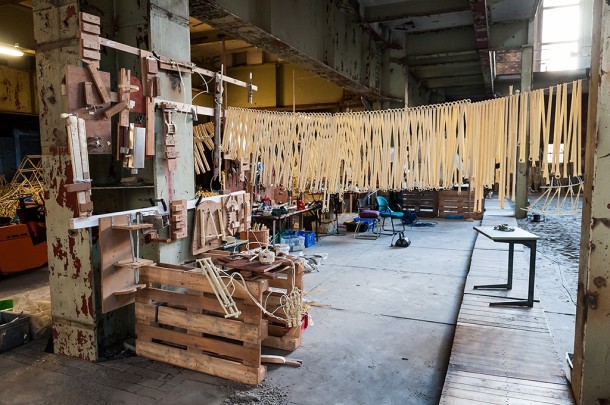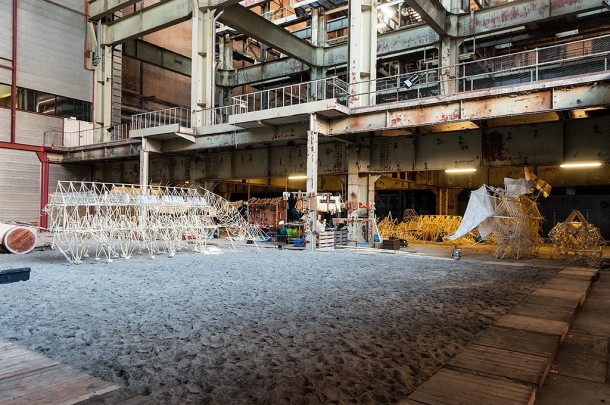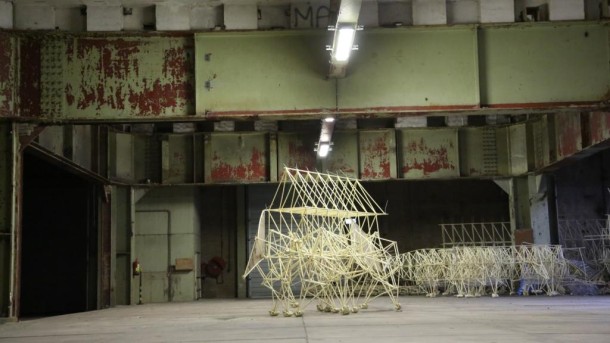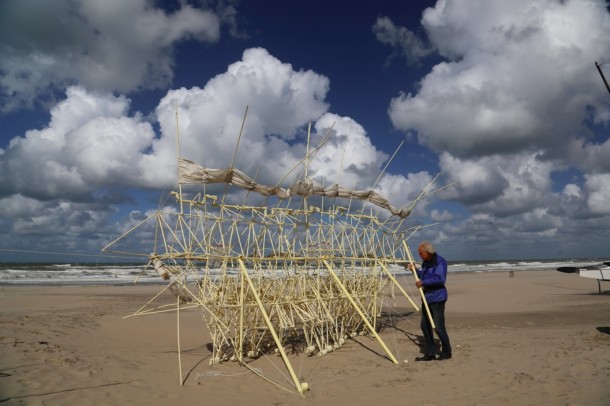World Artists and their Story, 8 - Theo Jansen
World Artists and their Story, 8 – Theo Jansen
Theo Jansen works already 24 years on his Strandbeest (Beach Beast). Last year in March I was in the former Electricity Factory in The Hague. On two floors there were many Beach Beasts standing in yellow beach sand. Immediately after the entrance of the factory the last offshoot of the Animaris pedigree, Animaris Suspendisse, was to be seen. It was completed for a larger part, but the finishing touch was still pending.
In front of many onlookers who wanted the see the beasts Theo Jansen gave an explanation and demonstration. ‘I will go in May to the beach with Animaris Suspendisse’, he said. There I’m planning to perform some experiments. In case it is windy I made a spoiler on his nose. Then he can move with his head towards the ground, so that he can hide as it were under his own nose. The Strandbeest always moves with his nose in the wind.’
Sailing
At the back of the beast we see a number of big plastic mineral water bottles, equipped with small tubes. In here is the energy of the beast, air can be pumped in and out. Above on his back he can protrude his wings, his sails to take advantage of the wind. Jansen puts the beach beast in motion. Children scream.
‘I let him walk from Kijkduin to Scheveningen. On hard sand. There must be Southwest wind. And when the beast has arrived in Scheveningen , we have to wait for the Northeast wind so that it can go back to Kijkduin again. The wind must have the right strength, force 3 / 4. Preferably there is low tide. The strandbeest navigates by touch. For this it uses his tail. He has buttresses to prevent it from falling by a sudden treacherous gust of wind.’
The muscles and the brains
A special pump gives it a sign that it has arrived in Scheveningen. Then the beast stops. After such a trek all his limbs are covered with fine sand and the beast likes to refresh briefly. He puts his sweat glands into effect. The sand is being washed away.
We walk to the machine that makes the parts of the beast. The machine has been designed by Job Kneppers from Delft. The basis is a thin yellow PVC conduit. The neural system consists of pumps and pistons going up and down in such a tube. A ‘folded’ tube is a cell. The machine produces one cell per minute. Theo Jansen: ‘You can see the neural system as a kind of muscle. The brains of the strandbeest work on a 0-1-0-1 system, like a computer works.’
Evolution
With another machine Jansen makes two rings at the end of the cell. In this way other part scan be attached. Theo Jansen: ‘I used to do this with strings, but if you do this a thousand times, you get a lame shoulder and arm. I searched very hard for a better method, and, after the advice of some people, I came up to the rings. That was an important innovation.’
‘I get the most ideas by doing, by encountering blockages in the material. So the material does the work, I am the slave who can put it together. In fact, I walk a path already trodden by the real evolution.’
3D printing
Are there any questions from the audience? ‘If there automatic recovery possible if the Beach Beast gets a damage?’ Jansen: ‘Not now, maybe in 150 years.’ ‘Ain’t it possible that Strandbeast willl be 3D printed?’ Jansen: ‘Could be, lets say in about ten years.’
After this explanation, we walk to the other beach animals, some of them you can let move yourself. We look at the movies. It is impressive, especially when we see one Beast moving with full sails with dark blue storm clouds above the sea.
http://www.strandbeest.com/
http://ifthenisnow.nl/nl/verhalen/de-wereld-van-de-haagse-kunstenaar-21-theo-jansen
Disclaimer: The views, opinions and positions expressed within this guest article are those of the author Walter van Teeffelen alone and do not represent those of the Marbella Marbella website. The accuracy, completeness and validity of any statements made within this article are not guaranteed. We accept no liability for any errors, omissions or representations. The copyright of this content belongs to Walter van Teeffelen and any liability with regards to infringement of intellectual property rights remains with the author.





















The opinions expressed by individual commentators and contributors do not necessarily constitute this website's position on the particular topic.